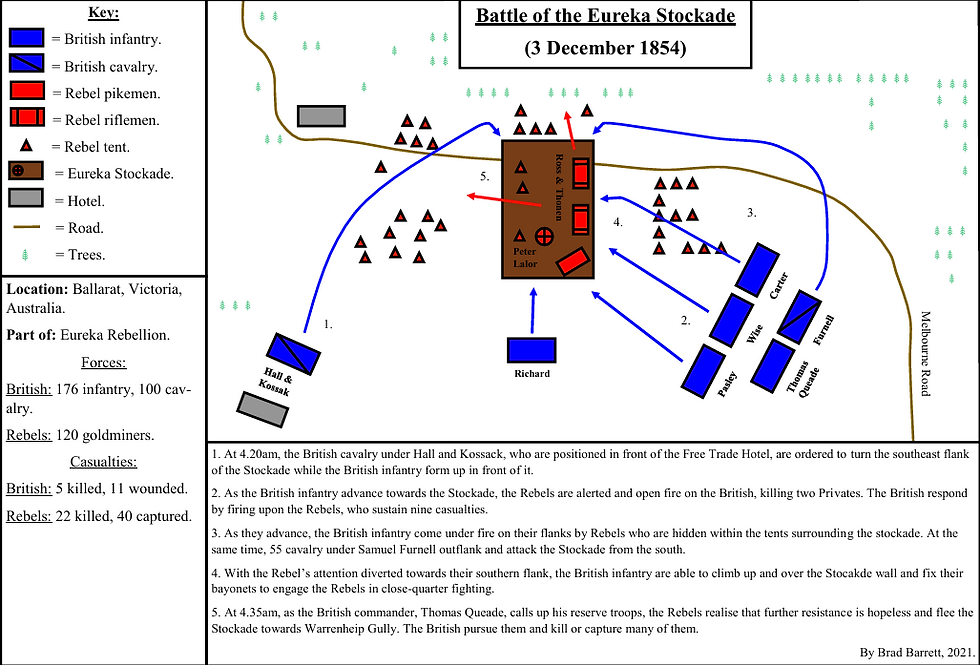The Battle of the Eureka Stockade.
- Brad Barrett

- Sep 10, 2020
- 4 min read
Updated: Nov 30

On 3 December 1854, the Battle of the Eureka Stockade was fought in Australia between Southern Cross Rebels under Peter Lalor and the British under Thomas Queade during the Eureka Rebellion.
Why did it happen?
In 1851, it was announced that gold had been discovered in New South Wales and Victoria, leading many people around the world to come to Australia to seek their fortunes. This led to Victoria's state population increasing exponentially from 77,000 in 1851 to 236,000 in 1854. The massive arrival of new people proved a serious challenge for the Australian government, which had limited finances to provide services. To raise funds, Governors Charles Fitzroy and Charles La Trobe imposed a license fee of 30 shillings a month on the gold miners. While this was a substantial amount for the diggers, when the surface gold began to run out in 1852, the license fee became a point of contention. Starting in 1853, miners began to gather and voice their complaints to Governor Charles La Trobe, who proved unreceptive to their requests. Police began to run “license hunts”, and when the murder of a Scottish miner on 6 October 1854 during an altercation at the Eureka Hotel was acquitted in a court of inquiry, the miners sensed a miscarriage of justice. On 11 November, the Ballarat Reform League was formed and petitioned the new lieutenant governor, Charles Hotham, for the redress of their grievances. However, when 450 British troops arrived on 28 November, Hotham dismissed the League’s grievances, and the miners organized themselves into military units, electing Peter Lalor as their commander-in-chief on 30 November. Using timber from nearby mineshafts, the miners then created a defensive stockade while many performed military drills to ready themselves for the upcoming battle.
Who was involved?
The Rebel forces at the Eureka Stockade numbered 120 goldminers. Out of this figure, 70 were armed with shotguns and rifles, while 30 were equipped with pistols. The remaining 20 were armed with pikes fashioned by the German blacksmith John Helfele, who was among the Rebel forces. While the 100 miners equipped with firearms were positioned along the western half of the Eureka Stockade, the 20 pikemen were positioned at the Stockade’s open point to repel any British soldiers who got close enough to use their bayonets. The British force at the Eureka Stockade numbered 176 infantry and 100 cavalry. The main force of 152 infantry under Thomas Queade was positioned to the north-west of the stockade with 55 cavalry under Samuel Furnell in reserve. 45 cavalry under Hall and Kossack were positioned in front of the Free Trade Hotel on Stockyard Hill, while the remaining 27 infantry under Richards were positioned below Stockyard Hill in front of the Stockade.
What happened?
At 4.20 am on 3 December, the British infantry formed up in front of the stockade while the 45 cavalry under Hall and Kossack rode towards the southeastern flank of the Stockade to surround it. As they did so, the Rebels were alerted and opened fire upon the British infantry advancing towards the stockade. In the opening exchange, two British privates were killed, and the British infantry opened fire upon the Rebels, killing nine. After ten minutes of fighting, the British came under fire from rebel diggers hidden within the tents surrounding the stockade, while 55 cavalry under Samuel Furnell were ordered to outflank and attack the stockade from the south. This distracted the Rebels' attention towards the southern flank, allowing the British infantry to climb up and over the stockade wall, fix their bayonets and engage the Rebel forces in hand-to-hand combat. At 4.35 am, Thomas Queade ordered his reserves to advance into the stockade, engaging the Rebel pikemen in close-quarter fighting. The remaining Rebel forces, who realized that the stockade had been overrun, fled southward towards the Warrenheip Gully, with the British in hot pursuit. By 4.40 am the battle was over, with the Rebels sustaining 22 killed and 40 captured, and British losses numbering 5 killed and 11 wounded.
What changed as a result?
The Battle of the Eureka Stockade was a British victory. However, it proved to be a hollow one. Although 13 rebel prisoners captured during the battle were put on trial at Melbourne Supreme Court and charged with High Treason, the jury found all thirteen men Not Guilty during a hearing on 21 March 1855. The significance of the battle is that, unlike previous attempts at democratic reform in Australia, the Eureka Rebellion led to the first democratic elections being held in Victoria and New South Wales between 1857 and 1859. By 1870, with the Payment of Members Act, the last of the Chartist demands were realized in Victoria, and Australia became a leader in the world for democratic reform. In the words of Peter Fitzsimons, “As a result of the political reforms ushered in by Eureka, Australia became nothing less than one of the key ‘lights on the hill’ for democratic movements around the world…The country would remain at the forefront of those reforms for decades to come” (Fitzsimons, 2012, p.612).
Bibliography
Blake, Gregory. The Eureka Stockade: 1854. Newport, Big Sky Publishing, 2023.
Editors of Encyclopaedia Britannica. “Eureka Stockade.” Encyclopaedia Britannica. Last revised May 11, 2020. https://www.britannica.com/event/Eureka-Stockade
Fitzsimons, Peter. Eureka: The Unfinished Revolution. Sydney, William Heinemann, 2012.
McMahon, Katherine. “Defining Moments: Eureka Stockade.” National Museum of Australia. Accessed March 20, 2020. https://www.nma.gov.au/defining-moments/resources/eureka-stockade



Comments